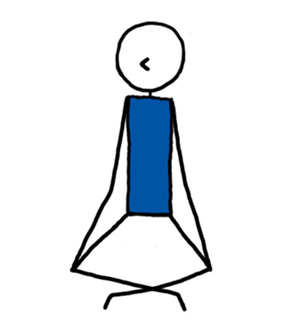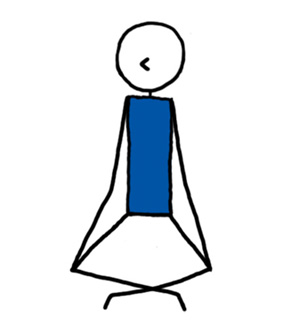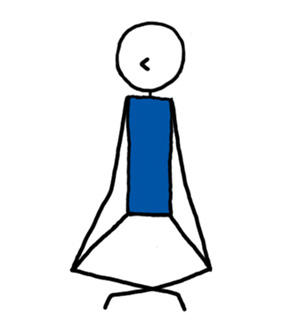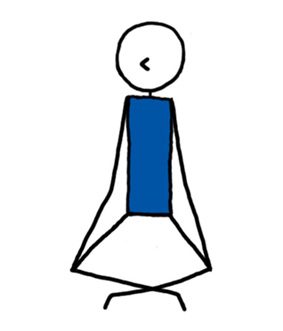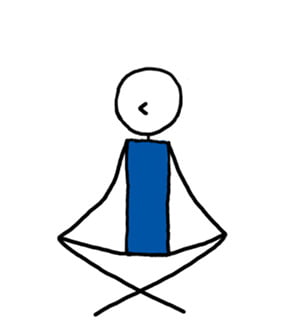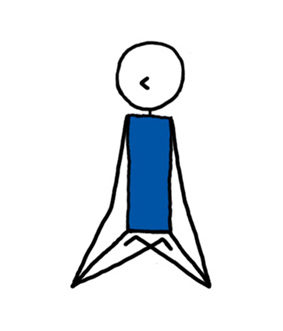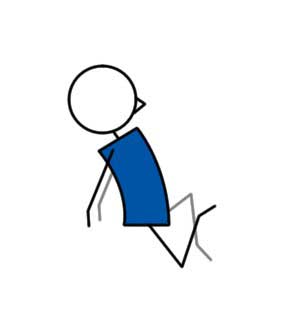
| Category: | Yoga Lesson Planner |
|---|---|
| Sub Category: | Mantras |
| Types: | Seated, Seated & Floor |
| Anatomy: | Core, Hamstrings, Hips, Psoas |
| Chakras: | Crown Centre, Third Eye |
| Therapy: | Anxiety, Depression, Eye fatigue, Fatigue, Headaches, Insomnia, Stress |
| Drishti: | Eyebrow |
| Dosha: | Kapha, Pitta, Vata |
| Meridian Lines: | All Meridians |
Om. Sat Chit Ananda Parabrahma. Purushothama Paramatma. Sri Bhagavathi Sametha. Sri Bhagavathe Namaha. Hari Om Tat Sat (repeat x4). Pronunciation: "ohm saht chit uh-nuhn-duh puh-ruh-brah-muh poo-roo-shoh-thuh-muh puh-ruh-maht-muh shree bhuh-guh-vuh-thee sah-may-thuh shree bhuh-guh-vuh-thay nuh-muh-hah". Translation: Divine Essence, Creator of All, Supreme Being, present within every living soul. The Ultimate Soul embodied as the Sacred Mother and the Holy Father, to whom I humbly bow in reverence.
Protection and freedom from all sorrow and suffering. Improved concentration. Stress reduction. Self-awareness. Emotional healing. Boosted immune system. Increased energy levels. Deeper spiritual practice.
A) Sit on a bolster, folded blanket, or block. B) Sit against a wall. C) Sit in a chair. D) Change the cross of the legs. E) Sit in Hero, Perfect or Lotus pose.
Be clear about intention when chanting mantras.
Click here for lots of FREE downloadable Yoga lesson plans.
Click here for lots of FREE downloadable Pilates lesson plans.
How to Teach Moola Mantra
Here’s a bit of background to give to your students about the mantra:
“Moola” (also spelt as “Mula” or “Mul”) is a Sanskrit word that translates to “root” or “foundation”.
The Moola Mantra is a powerful and sacred Sanskrit chant originating from ancient India. It is believed to invoke the energy and blessings of the Divine, particularly Ganesha, Goddess Lakshmi, and Vishnu.
The Moola Mantra consists of the following words:
“Om Sat Chit Ananda Parabrahma Purushothama Paramatma Sri Bhagavathi Sametha Sri Bhagavathe Namaha”
Next up, is the translation.
Moola Mantra Translation
The long translation:
Om (the primordial sound, representing the ultimate reality)
Sat (truth, existence)
Chit (consciousness)
Ananda (bliss)
Parabrahma (the supreme being)
Purushothama (the highest person, another name for Lord Vishnu)
Paramatma (the supreme soul)
Sri Bhagavathi (the divine feminine, referring to Goddess Lakshmi)
Sametha (together)
Sri Bhagavathe (the divine masculine, referring to Lord Vishnu)
Namaha (I bow, or I offer my salutations)
The short translation:
“Om, I bow to the supreme consciousness, the highest truth, united with divine masculine and feminine energies, embodied in Lord Vishnu and Goddess Lakshmi.”
The surfer dude’s translation:
“Om, dude, I totally bow to the cosmic vibes of truth and consciousness, and the rad divine couple, Lord Vishnu and Goddess Lakshmi, man!”
The quirky yoga teacher’s translation:
“Om, my fellow yogis, let’s give a big namaste to the grooviest cosmic truth and consciousness, and our divine cosmic duo, Lord Vishnu and Goddess Lakshmi!”
Next up, are the benefits.
Moola Mantra Benefits
The mantra is said to purify our energy, dispel negativity, and bring about clarity, abundance, and spiritual awakening.
Next up, is the pronunciation.
Moola Mantra Pronunciation
Here is the mantra without pronunciation:
“Om Sat Chit Ananda Parabrahma Purushothama Paramatma Sri Bhagavathi Sametha Sri Bhagavathe Namaha”
Here is the pronunciation for the mantra:
“ohm saht chit uh-nuhn-duh puh-ruh-brah-muh poo-roo-shoh-thuh-muh puh-ruh-maht-muh shree bhuh-guh-vuh-thee sah-may-thuh shree bhuh-guh-vuh-thay nuh-muh-hah”
Here is a breakdown of the pronunciation:
Om: “ohm”
Sat: “saht”
Chit: “chit”
Ananda: “uh-nuhn-duh”
Parabrahma: “puh-ruh-brah-muh”
Purushothama: “poo-roo-shoh-thuh-muh”
Paramatma: “puh-ruh-maht-muh”
Sri: “shree”
Bhagavathi: “bhuh-guh-vuh-thee”
Sametha: “sah-may-thuh”
Sri: “shree”
Bhagavathe: “bhuh-guh-vuh-thay”
Namaha: “nuh-muh-hah”
“ohm saht chit uh-nuhn-duh puh-ruh-brah-muh poo-roo-shoh-thuh-muh puh-ruh-maht-muh shree bhuh-guh-vuh-thee sah-may-thuh shree bhuh-guh-vuh-thay nuh-muh-hah”
Well done! Keep repeating it over and over again. Imagine you’re the famous singer of Mantras, Diva Premal, and sing the mantra (out loud or silently).
Next up, is how to practice the mantra.
How to Practice Moola Mantra
To practice the mantra, sit comfortably in a quiet space with your spine erect. Take a few deep breaths to calm your mind and body. Focus your attention on the base of your spine, and begin to chant the mantra aloud or silently. You can repeat the mantra as many times as you feel comfortable for 5 to 15 minutes.
Next up, are several free yoga philosophy lesson plans.
Free Yoga Philosophy Lesson Plans
As a yoga teacher, you know that yoga is much more than just a physical practice. It is a holistic approach to health and well-being that includes mental, emotional, and spiritual elements.
One of the fundamental aspects of yoga is its philosophy, which provides a framework for understanding the nature of reality, the human condition, and the purpose of life.
However, teaching yoga philosophy can be challenging, especially if you want to make it engaging and accessible to your students.
In this blog post, I share ten creative yoga philosophy lesson plan ideas (including the Eight Limbs Of Yoga, Purusha, Prakriti, and The Yoga Sutras) that will help you bring this essential aspect of yoga to life in your classes.
Next up, are the benefits of chanting, repeating, or meditating upon a mantra.
10 Benefits of Practising Mantras
Mantras offer various physical, mental, and spiritual benefits, including:
Cultivate Concentration: Chanting mantras can help calm the mind, improve concentration, and sharpen focus, making it easier to stay present during meditation or daily activities.
Stress Reduction: Repeating mantras can help lower stress levels by inducing a relaxed state and calming the nervous system.
Self-awareness: Mantra meditation can promote greater self-awareness and introspection, helping you better understand your thoughts and emotions.
Emotional Healing: Chanting mantras can help release emotional blockages, facilitate emotional healing, and promote inner peace and balance.
Boosted Immune System: The vibrations created by chanting mantras can stimulate the release of hormones that boost the immune system, promoting overall health and well-being.
Increased energy levels: Mantra meditation can help balance and energize the body’s chakras, leading to increased vitality and energy levels.
Spiritual Growth: Mantras can help you connect with your inner self, fostering spiritual growth and deepening your spiritual practice.
Improved Communication: Chanting mantras can strengthen the vocal cords and improve speech clarity, making it easier to communicate effectively with others.
Positive Vibrations: Mantras create positive vibrations that can transform negative energy, cleanse the environment, and uplift the mood.
Enhanced Memory: Regular practice of mantra meditation can improve memory, cognitive function, and overall brain health.
Next up, are different ways to sit in Easy Pose (Sukhasana).
Easy Pose (Sukhasana) Modifications
Here are some modifications to make sitting in Easy Pose (Sukhasana) more comfortable:
Sit on a bolster, folded blanket, or block: Elevating the hips can help maintain the natural curve of the lower back, making it easier to sit upright and reducing strain on the hips and knees.
Place a folded blanket or cushion under the knees: If the knees are elevated higher than the hips, supporting them with a blanket or cushion can reduce tension in the hip flexors and groin area.
Adjust foot placement: If crossing the ankles is uncomfortable, try placing one foot in front of the other instead of fully crossing the legs.
Sit against a wall: For additional support and to help maintain proper posture, you can sit with your back against a wall.
Use a chair: If sitting on the floor is too challenging, you can sit on a chair with your feet flat on the ground and knees bent at a 90-degree angle. Place a cushion or folded blanket on the chair for even more comfort.
Take breaks: If sitting in Easy Pose becomes uncomfortable, take breaks to extend the legs or change the cross of the legs.




 Yoga Lesson Planner
Yoga Lesson Planner
 Pilates Lesson Planner
Pilates Lesson Planner


